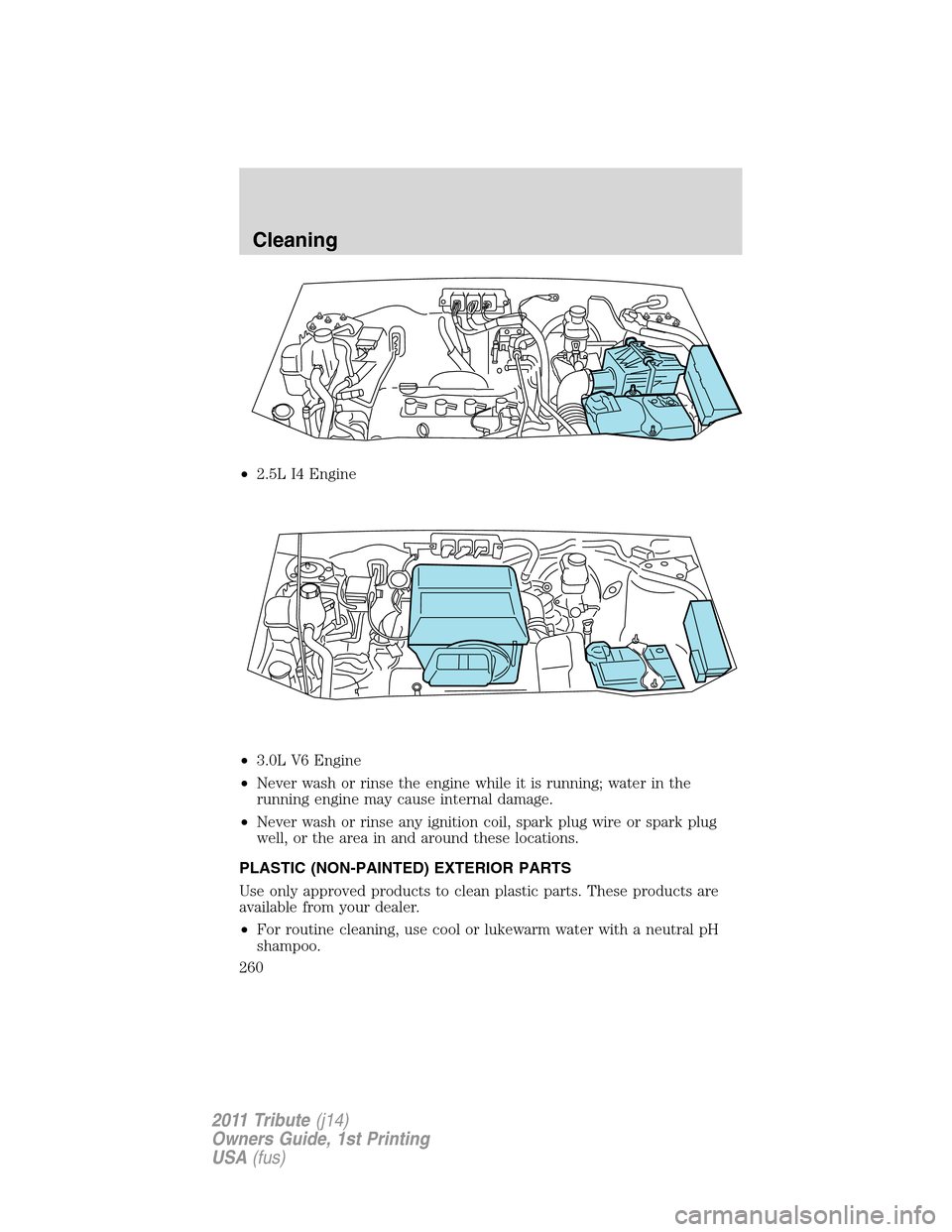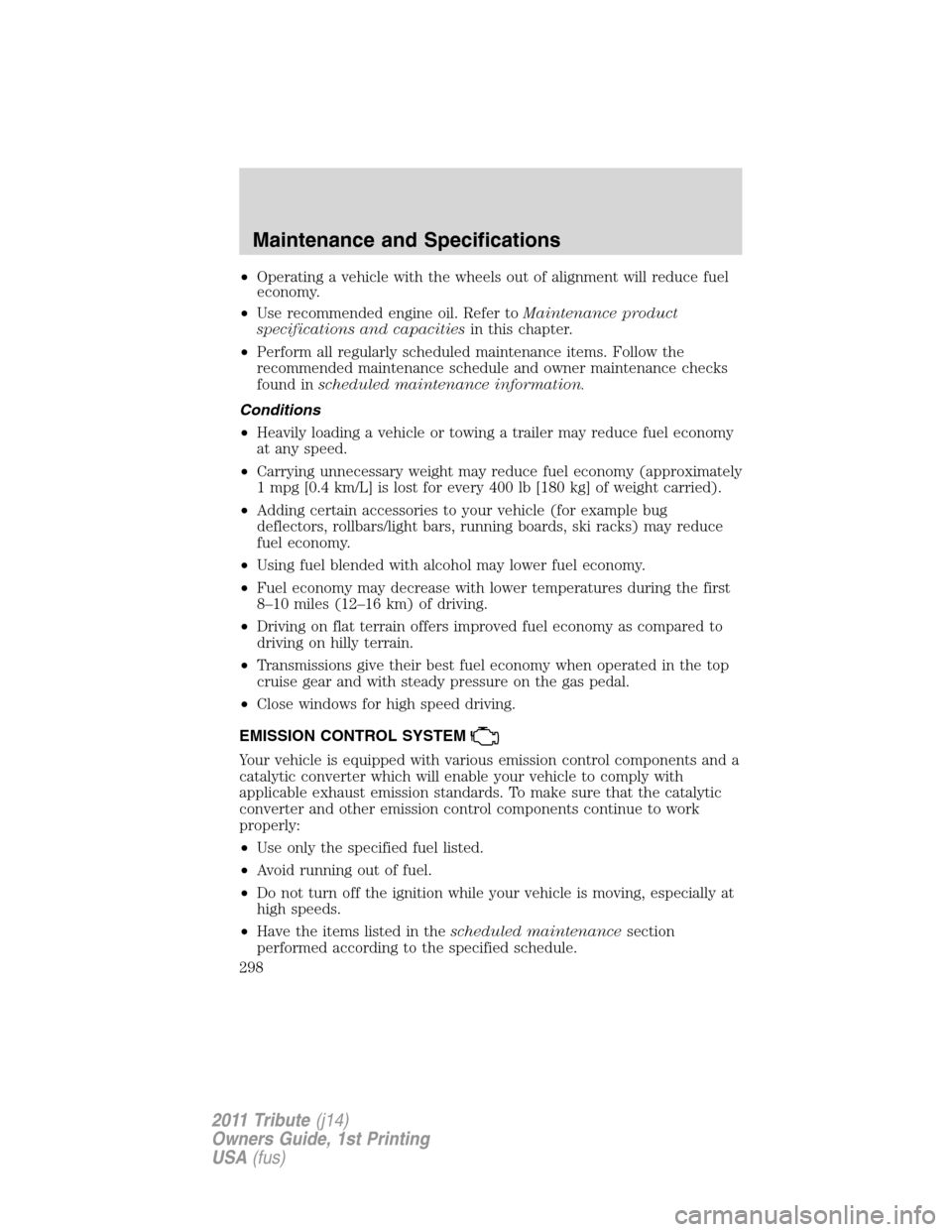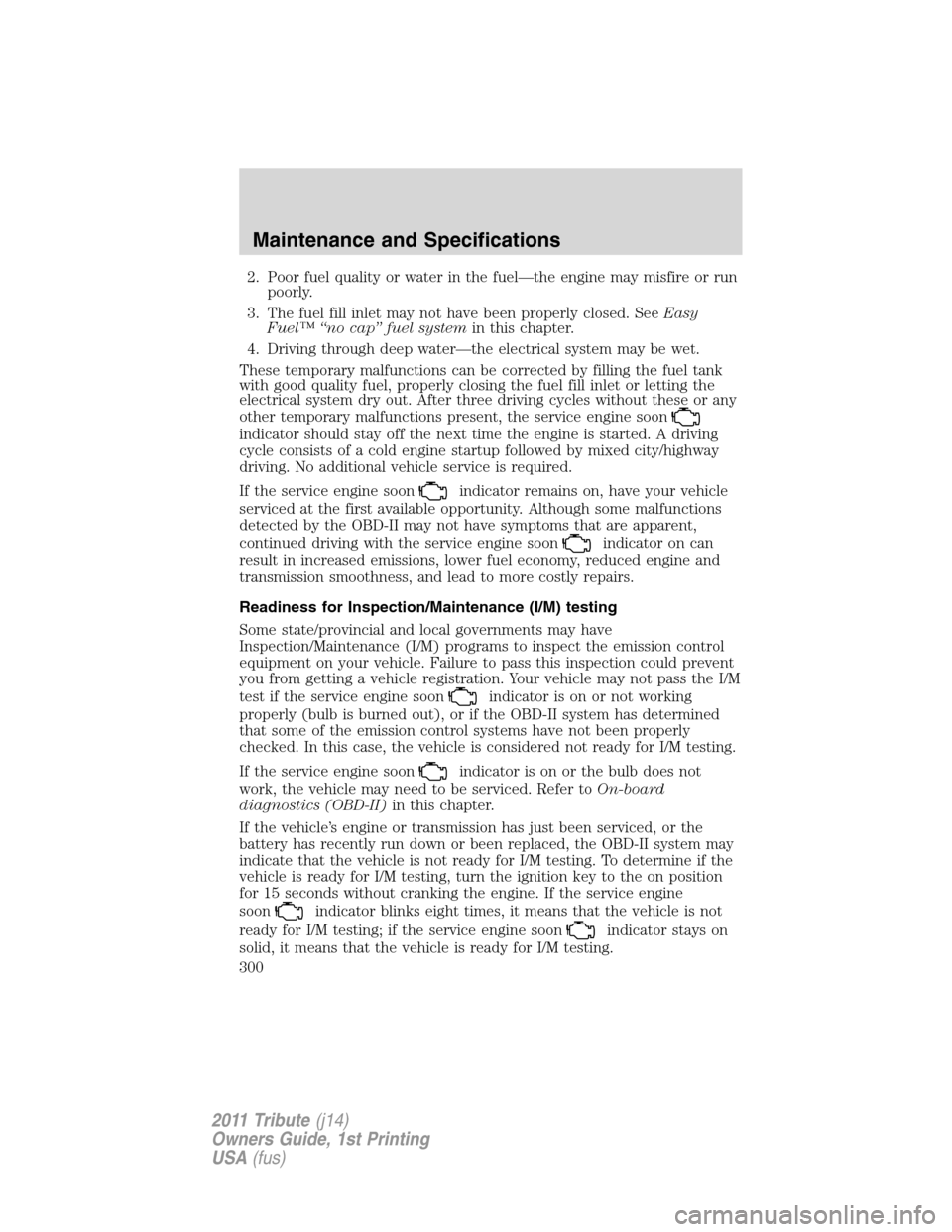ignition MAZDA MODEL TRIBUTE 2011 (in English) Workshop Manual
[x] Cancel search | Manufacturer: MAZDA, Model Year: 2011, Model line: MODEL TRIBUTE, Model: MAZDA MODEL TRIBUTE 2011Pages: 320, PDF Size: 2.08 MB
Page 225 of 320

Fuse/Relay
LocationFuse Amp
RatingProtected Circuits
14 15A* Trailer tow turn lamps
15 — Not used
16 40A** Cooling fan 1
17 40A** Cooling fan 2
18 20A** ABS solenoid
19 30A** Power seats
20 — A/C clutch relay
21A — Rear defroster relay
21B — Fuel relay
21C — Blower relay
21D — PCM relay
22 20A* Fuel pump
23 15A* Fuel injectors
24 — Not used
25 5A* ABS
26 15A* Ignition coils
27 10A* PCM – general powertrain
components malfunction indicator
lamp
28 20A* PCM – emission related
powertrain components
malfunction indicator lamp
29 15A* PCM
30A — Cooling fan 1 relay
30B — Starter relay
30C — Cooling fan main relay
30D — Cooling fan 2 relay
31A — Reverse lamp relay
31B — Not used
31C — Trailer tow left turn relay
31D — Trailer tow right turn relay
31E — Trailer tow park relay
Roadside Emergencies
225
2011 Tribute(j14)
Owners Guide, 1st Printing
USA(fus)
Page 237 of 320

Note:Inspect the wheel pilot hole
prior to installation. If there is
visible corrosion in wheel pilot hole,
remove loose particles by wiping
with clean rag and apply grease.
Apply grease only to the wheel pilot
hole surface by smearing a “dime”
(1 square cm) sized glob of grease
around the wheel pilot surface (1)
with end of finger. DO NOT apply
grease to lugnut/stud holes or
wheel-to-brake surfaces.
OVERHEATING
If the temperature gauge indicates overheating and you experience
power loss, you hear a loud knocking or pinging noise, the engine is
probably too hot.
If this happens:
1. Drive safely to the side of the road and park off the right-of-way.
2. Shift the automatic transmission into P (Park) or the manual
transmission into the neutral position, and apply the parking brake.
3. Turn off the air conditioner.
WARNING:Steam from an overheated engine is dangerous. The
escaping steam could seriously burn you. Open the hood ONLY
after steam is no longer escaping from the engine.
4. Check whether coolant or steam is escaping from under the hood or
from the engine compartment.
•If steam is coming from the engine compartment:do not go near
the front of the vehicle. Stop the engine, then turn the ignition switch
to the on position without starting the engine. The radiator cooling
fans will start to cool the engine.
•If neither coolant nor steam is escaping:open the hood and idle
the engine until it cools. If this does not lower the temperature, stop
the engine and let it cool.
5. Check the coolant level. If it is low, look for leaks in the radiator
hoses and connections, heater hoses and connections, radiator and
water pump.
If you find a leak or other damage, or if coolant is still leaking, stop the
engine and call an authorized dealer.
Roadside Emergencies
237
2011 Tribute(j14)
Owners Guide, 1st Printing
USA(fus)
Page 260 of 320

•2.5L I4 Engine
•3.0L V6 Engine
•Never wash or rinse the engine while it is running; water in the
running engine may cause internal damage.
•Never wash or rinse any ignition coil, spark plug wire or spark plug
well, or the area in and around these locations.
PLASTIC (NON-PAINTED) EXTERIOR PARTS
Use only approved products to clean plastic parts. These products are
available from your dealer.
•For routine cleaning, use cool or lukewarm water with a neutral pH
shampoo.
Cleaning
260
2011 Tribute(j14)
Owners Guide, 1st Printing
USA(fus)
Page 265 of 320

NOTE:After the described period, continue to follow the described
maintenance at the recommended intervals.
SCHEDULE 1
I:Inspect and repair, clean, adjust, or replace if necessary
(Oil-permeated air filter cannot be cleaned using the air-blow method)
R:Replace
L:Lubricate
Maintenance ItemMaintenance Interval (Months or miles [km], whichever
comes first)
Months 6 12 18 24 30 36 42 48 54 60 66 72
Miles x 1,000 7.5 15 22.5 30 37.5 45 52.5 60 67.5 75 82.5 90
(Km x 1,000) (12) (24) (36) (48) (60) (72) (84) (96) (108) (120) (132) (144)
ENGINE
Engine oil and filter1RRRRRRRRRRRR
Engine valve clearance (2.5L) Audible inspection every 75,000 miles (120,000 km);
adjust as necessary
Drive belt tension 2.5L I I
3.0L I I I
IGNITION SYSTEM
Spark plugs 2.5L Replace every 75,000 miles (120,000 km)
3.0L Replace every 90,000 miles (144,000 km)
FUEL SYSTEM
Air cleaner filter R R
Fuel tank Fill with a full tank of regular unleaded fuel every
3,000 miles (5,000 km) when use of E85 is 50% of the
time or greater
Fuel lines and hoses
2II I
Emission tubes and hoses2I
ENGINE COOLING SYSTEM
Engine coolant level I I I I I I I IIIII
Engine cooling system and hosesII I
Engine coolant Replace at 100,000 miles (160,000 km) or 72 months;
every 50,000 miles (80,000 km) or 36 months
thereafter
Maintenance and Specifications
265
2011 Tribute(j14)
Owners Guide, 1st Printing
USA(fus)
Page 267 of 320

4The wheel lug nuts must be retightened to the proper specifications at
500 miles (800 km) of new vehicle operation, at any wheel change, or at
any other time the wheel lug nuts have been loosened. Refer toWheel
lug nut torque specificationsin theTires, Wheels and Loading
chapter for the proper lug nut torque specification.
SCHEDULE 2
I:Inspect and repair, clean, adjust, or replace if necessary
(Oil-permeated air filter cannot be cleaned using the air-blow method)
R:Replace
L:Lubricate
Maintenance ItemMaintenance Interval (Months or miles [km], whichever
comes first)
Months 4 8 12 16 20 24 28 32 36 40 44 48
Milesx1,000 5 1015202530354045505560
(Km x 1,000) (8) (16) (24) (32) (40) (48) (56) (64) (72) (80) (88) (96)
ENGINE
Engine oil and filter (except Puerto
Rico)
1RRRRRRRRRRRR
Engine oil and filter (Puerto Rico)
1Replace every 3,000 miles (5,000 km) or 3 months
Engine valve clearance (2.5L) Audible inspection every 75,000 miles
(120,000 km); adjust as necessary
Drive belt tension 2.5L I
3.0L I I
IGNITION SYSTEM
Spark plugs 2.5L US engine Replace every 60,000 miles (96,000 km)
3.0L US engine Replace every 75,000 miles (120,000 km)
All others
2Replace every 75,000 miles (120,000 km)
FUEL SYSTEM
Air cleaner filter Puerto Rico R R
All others R
Fuel tank Fill with a full tank of regular unleaded fuel every
3,000 miles (5,000 km) when use of E85 is 50%
of the time or greater
Fuel lines and hoses
3II
Emission tubes and hoses3I
Maintenance and Specifications
267
2011 Tribute(j14)
Owners Guide, 1st Printing
USA(fus)
Page 294 of 320

rating. These products have not been approved for your engine and
could cause damage to the fuel system. Repairs to correct the effects of
using an aftermarket product in your fuel may not be covered by your
warranty.
Many of the world’s automakers approved the World-Wide Fuel Charter
that recommends gasoline specifications to provide improved
performance and emission control system protection for your vehicle.
Gasolines that meet the World-Wide Fuel Charter should be used when
available. Ask your fuel supplier about gasolines that meet the
World-Wide Fuel Charter.
Cleaner air
Mazda endorses the use of reformulated “cleaner-burning” gasolines to
improve air quality, per the recommendations in theChoosing the right
fuelsection.
Running out of fuel
Avoid running out of fuel because this situation may have an adverse
effect on powertrain components.
If you have run out of fuel:
•You may need to cycle the ignition from off to on several times after
refueling to allow the fuel system to pump the fuel from the tank to
the engine. On restarting, cranking time will take a few seconds longer
than normal.
•Normally, adding 1 gallon (3.8L) of fuel is enough to restart the
engine. If the vehicle is out of fuel and on a steep grade, more than
1 gallon (3.8L) may be required.
•The service engine soon
indicator may come on. For more
information on the service engine soon indicator, refer toWarning
lights and chimesin theInstrument Clusterchapter.
Refilling with a portable fuel container
With the Easy Fuel™ “no cap” fuel system, use the following directions
when filling from a portable fuel container:
WARNING:Do not insert the nozzle of portable fuel containers
or aftermarket funnels into the Easy Fuel™ system. This could
damage the fuel system and its seal, and may cause fuel to run onto
the ground instead of filling the tank, which could result in serious
personal injury.
Maintenance and Specifications
294
2011 Tribute(j14)
Owners Guide, 1st Printing
USA(fus)
Page 296 of 320

measure of fuel economy. We do not recommend taking fuel economy
measurements during the first 1,000 miles (1,600 km) of driving (engine
break-in period). You will get a more accurate measurement after
2,000 miles–3,000 miles (3,000 km–5,000 km).
Filling the tank
The advertised fuel capacity of the fuel tank on your vehicle is equal to
the rated refill capacity of the fuel tank as listed in theMaintenance
product specifications and capacitiessection of this chapter.
The advertised capacity is the amount of the indicated capacity and the
empty reserve combined. Indicated capacity is the difference in the
amount of fuel in a full tank and a tank when the fuel gauge indicates
empty. Empty reserve is the small amount of fuel remaining in the fuel
tank after the fuel gauge indicates empty.
The amount of usable fuel in the empty reserve varies and should
not be relied upon to increase driving range. When refueling your
vehicle after the fuel gauge indicates empty, you might not be
able to refuel the full amount of the advertised capacity of the
fuel tank due to the empty reserve still present in the tank.
For consistent results when filling the fuel tank:
•Turn the engine/ignition switch to the off position prior to refueling,
an error in the reading will result if the engine is left running.
•Use the same filling rate setting (low — medium — high) each time
the tank is filled.
•Allow no more than two automatic click-offs when filling.
•Always use fuel with the recommended octane rating.
•Use a known quality gasoline, preferably a national brand.
•Have the vehicle loading and distribution the same every time.
Your results will be most accurate if your filling method is consistent.
Calculating fuel economy
1. Fill the fuel tank completely and record the initial odometer reading
(in miles or kilometers).
2. Each time you fill the tank, record the amount of fuel added (in
gallons or liters).
3. After at least three to five tank fill-ups, fill the fuel tank and record
the current odometer reading.
4. Subtract your initial odometer reading from the current odometer
reading.
Maintenance and Specifications
296
2011 Tribute(j14)
Owners Guide, 1st Printing
USA(fus)
Page 298 of 320

•Operating a vehicle with the wheels out of alignment will reduce fuel
economy.
•Use recommended engine oil. Refer toMaintenance product
specifications and capacitiesin this chapter.
•Perform all regularly scheduled maintenance items. Follow the
recommended maintenance schedule and owner maintenance checks
found inscheduled maintenance information.
Conditions
•Heavily loading a vehicle or towing a trailer may reduce fuel economy
at any speed.
•Carrying unnecessary weight may reduce fuel economy (approximately
1 mpg [0.4 km/L] is lost for every 400 lb [180 kg] of weight carried).
•Adding certain accessories to your vehicle (for example bug
deflectors, rollbars/light bars, running boards, ski racks) may reduce
fuel economy.
•Using fuel blended with alcohol may lower fuel economy.
•Fuel economy may decrease with lower temperatures during the first
8–10 miles (12–16 km) of driving.
•Driving on flat terrain offers improved fuel economy as compared to
driving on hilly terrain.
•Transmissions give their best fuel economy when operated in the top
cruise gear and with steady pressure on the gas pedal.
•Close windows for high speed driving.
EMISSION CONTROL SYSTEM
Your vehicle is equipped with various emission control components and a
catalytic converter which will enable your vehicle to comply with
applicable exhaust emission standards. To make sure that the catalytic
converter and other emission control components continue to work
properly:
•Use only the specified fuel listed.
•Avoid running out of fuel.
•Do not turn off the ignition while your vehicle is moving, especially at
high speeds.
•Have the items listed in thescheduled maintenancesection
performed according to the specified schedule.
Maintenance and Specifications
298
2011 Tribute(j14)
Owners Guide, 1st Printing
USA(fus)
Page 300 of 320

2. Poor fuel quality or water in the fuel—the engine may misfire or run
poorly.
3. The fuel fill inlet may not have been properly closed. SeeEasy
Fuel™ “no cap” fuel systemin this chapter.
4. Driving through deep water—the electrical system may be wet.
These temporary malfunctions can be corrected by filling the fuel tank
with good quality fuel, properly closing the fuel fill inlet or letting the
electrical system dry out. After three driving cycles without these or any
other temporary malfunctions present, the service engine soon
indicator should stay off the next time the engine is started. A driving
cycle consists of a cold engine startup followed by mixed city/highway
driving. No additional vehicle service is required.
If the service engine soon
indicator remains on, have your vehicle
serviced at the first available opportunity. Although some malfunctions
detected by the OBD-II may not have symptoms that are apparent,
continued driving with the service engine soon
indicator on can
result in increased emissions, lower fuel economy, reduced engine and
transmission smoothness, and lead to more costly repairs.
Readiness for Inspection/Maintenance (I/M) testing
Some state/provincial and local governments may have
Inspection/Maintenance (I/M) programs to inspect the emission control
equipment on your vehicle. Failure to pass this inspection could prevent
you from getting a vehicle registration. Your vehicle may not pass the I/M
test if the service engine soon
indicator is on or not working
properly (bulb is burned out), or if the OBD-II system has determined
that some of the emission control systems have not been properly
checked. In this case, the vehicle is considered not ready for I/M testing.
If the service engine soon
indicator is on or the bulb does not
work, the vehicle may need to be serviced. Refer toOn-board
diagnostics (OBD-II)in this chapter.
If the vehicle’s engine or transmission has just been serviced, or the
battery has recently run down or been replaced, the OBD-II system may
indicate that the vehicle is not ready for I/M testing. To determine if the
vehicle is ready for I/M testing, turn the ignition key to the on position
for 15 seconds without cranking the engine. If the service engine
soon
indicator blinks eight times, it means that the vehicle is not
ready for I/M testing; if the service engine soon
indicator stays on
solid, it means that the vehicle is ready for I/M testing.
Maintenance and Specifications
300
2011 Tribute(j14)
Owners Guide, 1st Printing
USA(fus)
Page 311 of 320

ENGINE SPECIFICATIONS
Engine 2.5L I4 engine 3.0L V6 engine
Cubic inches 152 183
Required fuel 87 octane 87 octane or E85
Firing order 1-3-4-2 1-4-2-5-3-6
Ignition system Coil on plug Coil on plug
Spark plug gap 0.049–0.053 inch
(1.25–1.35mm)0.045–0.049 inch
(1.15–1.25mm)
Compression ratio 9.7:1 10.3:1
Engine drivebelt routing
•2.5L I4 Engine
•3.0L V6 Engine
Maintenance and Specifications
311
2011 Tribute(j14)
Owners Guide, 1st Printing
USA(fus)